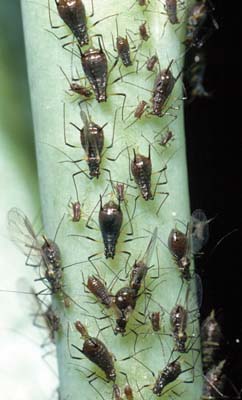To save the Web-optimized images shown below to your hard drive:
|
Click to access Display and Print quality images. |
Host plants that are attacked by the lettuce aphid include chicory, radicchio, and lettuce. Weed species that serve as hosts are sowthistle, wild lettuce, horseweed, Carolina false dandelion, and dandelion in the family Asteraceae. Few natural enemies are, as yet, identified. Young plants are often treated with an insecticide before transplanting to guard against infestation. Systemic insecticides are usually recommended if the aphids are detected. Cultural control practices include destruction of crop residue and destruction of weeds that serve as alternate hosts.
Images
To save the Web-optimized images shown below to your hard drive:

Brown lettuce aphid, Uroleucon
pseudambrosiae, colony of mixed
ages and wing forms.
(Photographer: J. Castner,
University of Florida)
Click to access Display and Print quality images.
|
Click to access Display and Print quality images. |